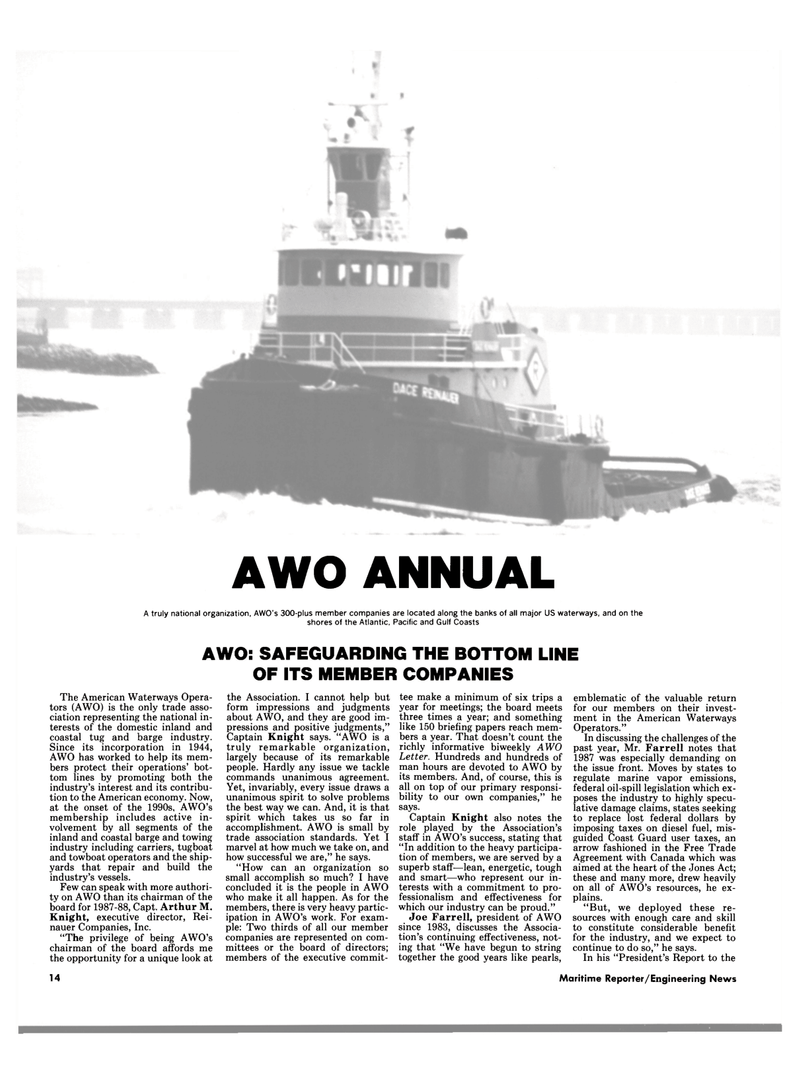
Page 12: of Maritime Reporter Magazine (March 1988)
Read this page in Pdf, Flash or Html5 edition of March 1988 Maritime Reporter Magazine
AWO ANNUAL
A truly national organization, AWO's 300-plus member companies are located along the banks of all major US waterways, and on the shores of the Atlantic, Pacific and Gulf Coasts
AWO: SAFEGUARDING THE BOTTOM LINE
OF ITS MEMBER COMPANIES
The American Waterways Opera- tors (AWO) is the only trade asso- ciation representing the national in- terests of the domestic inland and coastal tug and barge industry.
Since its incorporation in 1944,
AWO has worked to help its mem- bers protect their operations' bot- tom lines by promoting both the industry's interest and its contribu- tion to the American economy. Now, at the onset of the 1990s, AWO's membership includes active in- volvement by all segments of the inland and coastal barge and towing industry including carriers, tugboat and towboat operators and the ship- yards that repair and build the industry's vessels.
Few can speak with more authori- ty on AWO than its chairman of the board for 1987-88, Capt. Arthur M.
Knight, executive director, Rei- nauer Companies, Inc. "The privilege of being AWO's chairman of the board affords me the opportunity for a unique look at the Association. I cannot help but form impressions and judgments about AWO, and they are good im- pressions and positive judgments,"
Captain Knight says. "AWO is a truly remarkable organization, largely because of its remarkable people. Hardly any issue we tackle commands unanimous agreement.
Yet, invariably, every issue draws a unanimous spirit to solve problems the best way we can. And, it is that spirit which takes us so far in accomplishment. AWO is small by trade association standards. Yet I marvel at how much we take on, and how successful we are," he says. "How can an organization so small accomplish so much? I have concluded it is the people in AWO who make it all happen. As for the members, there is very heavy partic- ipation in AWO's work. For exam- ple: Two thirds of all our member companies are represented on com- mittees or the board of directors; members of the executive commit- tee make a minimum of six trips a year for meetings; the board meets three times a year; and something like 150 briefing papers reach mem- bers a year. That doesn't count the richly informative biweekly AWO
Letter. Hundreds and hundreds of man hours are devoted to AWO by its members. And, of course, this is all on top of our primary responsi- bility to our own companies," he says.
Captain Knight also notes the role played by the Association's staff in AWO's success, stating that "In addition to the heavy participa- tion of members, we are served by a superb staff—lean, energetic, tough and smart—who represent our in- terests with a commitment to pro- fessionalism and effectiveness for which our industry can be proud."
Joe Farrell, president of AWO since 1983, discusses the Associa- tion's continuing effectiveness, not- ing that "We have begun to string together the good years like pearls, emblematic of the valuable return for our members on their invest- ment in the American Waterways
Operators."
In discussing the challenges of the past year, Mr. Farrell notes that 1987 was especially demanding on the issue front. Moves by states to regulate marine vapor emissions, federal oil-spill legislation which ex- poses the industry to highly specu- lative damage claims, states seeking to replace lost federal dollars by imposing taxes on diesel fuel, mis- guided Coast Guard user taxes, an arrow fashioned in the Free Trade
Agreement with Canada which was aimed at the heart of the Jones Act; these and many more, drew heavily on all of AWO's resources, he ex- plains. "But, we deployed these re- sources with enough care and skill to constitute considerable benefit for the industry, and we expect to continue to do so," he says.
In his "President's Report to the 14 Maritime Reporter/Engineering News

 11
11

 13
13
